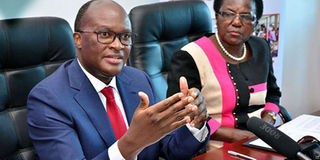Hope of reviving railway line to Kisumu dimmed

Transport Cabinet Secretary James Macharia (left), flanked by Uganda's Minister of Works Monica Azuba Ntege, addresses the Ugandan delegation at Inland Container Depot in Embakasi on May 8, 2019. The two countries are in talks to improve transport infrastructure. PHOTO | FRANCIS NDERITU | NATION MEDIA GROUP
What you need to know:
- Exclusion of the Kisumu line in the latest railway plan now edges the lakeside town from one of Kenya’s most active transport corridors.
- SGR talks took centre stage during Mr Museveni’s visit, including an offer of land for Uganda to build a dry port in Naivasha.
Days after China pulled the plug on the standard gauge railway (SGR) extension to Kisumu, a glimmer of hope that the old metre-gauge railway would be repaired to serve the region has fizzled out.
The government will not revive the Nakuru-Kisumu railway line, presenting a double blow to the lakeside city after the SGR project stopped in Naivasha.
Transport and Infrastructure Cabinet Secretary James Macharia on Wednesday said the government had opted to revamp the Naivasha-Malaba line instead at a cost of Sh15 billion as the Kisumu line was “badly damaged”.
“The reality is that the Nakuru-Kisumu line is not in good shape; it has 17 bridges, which have been vandalised, so it may require doing a new line altogether,” he said.
“We will have to weigh that against the fact that in future, we still have to do the SGR to Kisumu. The line is in very bad shape, so we may not possibly consider that option.”
CARGO
Until last weekend, the minister had maintained that both the lines to Malaba and Kisumu would be revived.
Mr Macharia also said that only Sh21 billion will be needed to revive both the old railway to Malaba and build a new 43km link from the Naivasha station, where the SGR currently ends. In China, he had put the figure at Sh40 billion.
Exclusion of the Kisumu line in the latest railway plan now edges the lakeside town from one of Kenya’s most active transport corridors.
A proposal that will see more trucks on the road between the two railway lines from August has also been introduced.
This may present a pricing headache for transporters, who will be required to use the railway from Mombasa to Duka Moja, where the SGR ends, and truck their cargo to the old railway station in Naivasha.
DRY PORT
Mr Macharia, who was speaking after hosting a delegation from Uganda, maintained that transporters will have time savings to compensate for any cost implications of the road transport between the two railway lines.
The Uganda team, led by Works and Transport Minister Monica Azuba, is on a week-long tour of Kenya to follow up on the March visit by President Yoweri Museveni.
SGR talks took centre stage during Mr Museveni’s visit, including an offer of land for Uganda to build a dry port in Naivasha.
“We’re very happy for the land offer in Naivasha, and we hope to see it during our tour, which will proceed all the way to the Malaba border,” Ms Azuba said.
BUSINESS
After the failure to secure funding for the Naivasha-Kisumu stretch of the SGR, residents along the old railway line had hoped that the new plan to revive the old railway was their rebound. This followed Mr Macharia’s announcement to that effect.
But the latest twist may be good news for various businesses, which had leased railway station buildings and converted them to bars, restaurants and churches.
Kisumu was to be a big player in the lake transport corridor, with some Sh14 billion having been part of the SGR plan that now remains in limbo.





